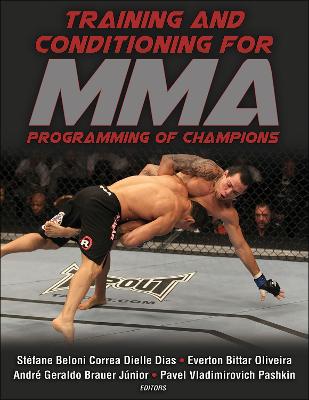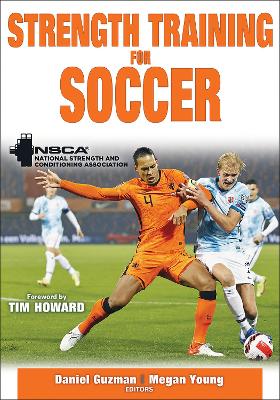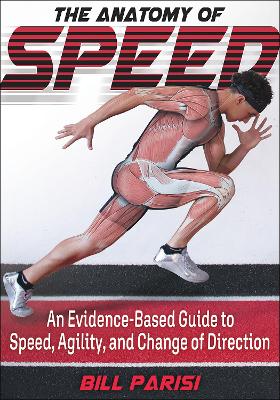Training and Conditioning for MMA
 -15%
portes grátis
-15%
portes grátis
Training and Conditioning for MMA
Programming of Champions
Beloni Correa Dielle Dias, Stefane; Oliveira, Everton Bittar; Pashkin, Pavel Vladimirovich; Brauer Junior, Andre Geraldo
Human Kinetics Publishers
08/2022
432
Mole
Inglês
9781492598619
15 a 20 dias
1202
Descrição não disponível.
Chapter 1. Concepts in the Methodology of Sports Training
Overload Principle Applied to Sports Training
Modes of Training
Traditional Periodization Methods
Block Periodization
Periodization Model Used at American Top Team
Construction of a Training Session
Chapter 2. Program Design
Principles of Resistance Training
Resistance Training for Strength and Muscle Hypertrophy
Resistance Training for Power
High-Intensity Interval Training
New Russian Concept of Training
Methods of Training the Heart Muscle
Methods of Directing Adipose Tissue Activity
Heat Acclimation
Chapter 3. Physical Assessment of the Fighter
Body Composition
Metabolic and Cardiorespiratory Fitness: Laboratory Testing
Metabolic and Cardiorespiratory Fitness: Field Testing
Tests Specific to Fighters
Neuromuscular-Musculoskeletal Fitness
Velocity
Flexibility
Chapter 4. The Importance of Nutrition in High-Level Training
Energy
Carbohydrates
Protein
Fat
Vitamins
Minerals
Ergogenic Aids
Chapter 5. Methods of Training for MMA
Body Weight Training
Resistance Training
Agonist-Antagonist Training
Eccentric Training
Functional Training
Suspension Training
Power Training
Specific Power Training
Power Endurance Training
Speed Training
Agility Training
Precompetition Training
MMA-Specific Cross Training
Training for Adaptive MMA Athletes
Training to Improve MMA Takedowns
MMA, Muay Thai, and Jiu-Jitsu Preparation Training for Women
Training for Wrestlers and Grapplers
Training for Jiu-Jitsu
Outdoor Training for MMA
High-Intensity Interval Training for MMA
Circuits for Five-Round Matches
Resistance Band Training
Training Using the Isoton Method
Training to Increase Muscular Endurance and Number of Mitochondria in Type II Muscle Fibers
Training to Increase Strength and Power in Type II Muscle Fibers
Training to Increase Speed
Chapter 6. Prevention of MMA-Related Injuries
Injury Prevention in MMA Fighters
Head and Face Injuries
Spinal Injuries
Elbow, Wrist, and Hand Injuries
Shoulder Injuries
Hip and Thigh Injuries
Knee Injuries
Ankle and Foot Injuries
The Science of Stretching and Flexibility
Overload Principle Applied to Sports Training
Modes of Training
Traditional Periodization Methods
Block Periodization
Periodization Model Used at American Top Team
Construction of a Training Session
Chapter 2. Program Design
Principles of Resistance Training
Resistance Training for Strength and Muscle Hypertrophy
Resistance Training for Power
High-Intensity Interval Training
New Russian Concept of Training
Methods of Training the Heart Muscle
Methods of Directing Adipose Tissue Activity
Heat Acclimation
Chapter 3. Physical Assessment of the Fighter
Body Composition
Metabolic and Cardiorespiratory Fitness: Laboratory Testing
Metabolic and Cardiorespiratory Fitness: Field Testing
Tests Specific to Fighters
Neuromuscular-Musculoskeletal Fitness
Velocity
Flexibility
Chapter 4. The Importance of Nutrition in High-Level Training
Energy
Carbohydrates
Protein
Fat
Vitamins
Minerals
Ergogenic Aids
Chapter 5. Methods of Training for MMA
Body Weight Training
Resistance Training
Agonist-Antagonist Training
Eccentric Training
Functional Training
Suspension Training
Power Training
Specific Power Training
Power Endurance Training
Speed Training
Agility Training
Precompetition Training
MMA-Specific Cross Training
Training for Adaptive MMA Athletes
Training to Improve MMA Takedowns
MMA, Muay Thai, and Jiu-Jitsu Preparation Training for Women
Training for Wrestlers and Grapplers
Training for Jiu-Jitsu
Outdoor Training for MMA
High-Intensity Interval Training for MMA
Circuits for Five-Round Matches
Resistance Band Training
Training Using the Isoton Method
Training to Increase Muscular Endurance and Number of Mitochondria in Type II Muscle Fibers
Training to Increase Strength and Power in Type II Muscle Fibers
Training to Increase Speed
Chapter 6. Prevention of MMA-Related Injuries
Injury Prevention in MMA Fighters
Head and Face Injuries
Spinal Injuries
Elbow, Wrist, and Hand Injuries
Shoulder Injuries
Hip and Thigh Injuries
Knee Injuries
Ankle and Foot Injuries
The Science of Stretching and Flexibility
Este título pertence ao(s) assunto(s) indicados(s). Para ver outros títulos clique no assunto desejado.
Mixed martial arts; strength training; conditioning; cross training; combat sports; mma; muay thai; brazilian jiu jitsu; grappling; wrestling; boxing; fight
Chapter 1. Concepts in the Methodology of Sports Training
Overload Principle Applied to Sports Training
Modes of Training
Traditional Periodization Methods
Block Periodization
Periodization Model Used at American Top Team
Construction of a Training Session
Chapter 2. Program Design
Principles of Resistance Training
Resistance Training for Strength and Muscle Hypertrophy
Resistance Training for Power
High-Intensity Interval Training
New Russian Concept of Training
Methods of Training the Heart Muscle
Methods of Directing Adipose Tissue Activity
Heat Acclimation
Chapter 3. Physical Assessment of the Fighter
Body Composition
Metabolic and Cardiorespiratory Fitness: Laboratory Testing
Metabolic and Cardiorespiratory Fitness: Field Testing
Tests Specific to Fighters
Neuromuscular-Musculoskeletal Fitness
Velocity
Flexibility
Chapter 4. The Importance of Nutrition in High-Level Training
Energy
Carbohydrates
Protein
Fat
Vitamins
Minerals
Ergogenic Aids
Chapter 5. Methods of Training for MMA
Body Weight Training
Resistance Training
Agonist-Antagonist Training
Eccentric Training
Functional Training
Suspension Training
Power Training
Specific Power Training
Power Endurance Training
Speed Training
Agility Training
Precompetition Training
MMA-Specific Cross Training
Training for Adaptive MMA Athletes
Training to Improve MMA Takedowns
MMA, Muay Thai, and Jiu-Jitsu Preparation Training for Women
Training for Wrestlers and Grapplers
Training for Jiu-Jitsu
Outdoor Training for MMA
High-Intensity Interval Training for MMA
Circuits for Five-Round Matches
Resistance Band Training
Training Using the Isoton Method
Training to Increase Muscular Endurance and Number of Mitochondria in Type II Muscle Fibers
Training to Increase Strength and Power in Type II Muscle Fibers
Training to Increase Speed
Chapter 6. Prevention of MMA-Related Injuries
Injury Prevention in MMA Fighters
Head and Face Injuries
Spinal Injuries
Elbow, Wrist, and Hand Injuries
Shoulder Injuries
Hip and Thigh Injuries
Knee Injuries
Ankle and Foot Injuries
The Science of Stretching and Flexibility
Overload Principle Applied to Sports Training
Modes of Training
Traditional Periodization Methods
Block Periodization
Periodization Model Used at American Top Team
Construction of a Training Session
Chapter 2. Program Design
Principles of Resistance Training
Resistance Training for Strength and Muscle Hypertrophy
Resistance Training for Power
High-Intensity Interval Training
New Russian Concept of Training
Methods of Training the Heart Muscle
Methods of Directing Adipose Tissue Activity
Heat Acclimation
Chapter 3. Physical Assessment of the Fighter
Body Composition
Metabolic and Cardiorespiratory Fitness: Laboratory Testing
Metabolic and Cardiorespiratory Fitness: Field Testing
Tests Specific to Fighters
Neuromuscular-Musculoskeletal Fitness
Velocity
Flexibility
Chapter 4. The Importance of Nutrition in High-Level Training
Energy
Carbohydrates
Protein
Fat
Vitamins
Minerals
Ergogenic Aids
Chapter 5. Methods of Training for MMA
Body Weight Training
Resistance Training
Agonist-Antagonist Training
Eccentric Training
Functional Training
Suspension Training
Power Training
Specific Power Training
Power Endurance Training
Speed Training
Agility Training
Precompetition Training
MMA-Specific Cross Training
Training for Adaptive MMA Athletes
Training to Improve MMA Takedowns
MMA, Muay Thai, and Jiu-Jitsu Preparation Training for Women
Training for Wrestlers and Grapplers
Training for Jiu-Jitsu
Outdoor Training for MMA
High-Intensity Interval Training for MMA
Circuits for Five-Round Matches
Resistance Band Training
Training Using the Isoton Method
Training to Increase Muscular Endurance and Number of Mitochondria in Type II Muscle Fibers
Training to Increase Strength and Power in Type II Muscle Fibers
Training to Increase Speed
Chapter 6. Prevention of MMA-Related Injuries
Injury Prevention in MMA Fighters
Head and Face Injuries
Spinal Injuries
Elbow, Wrist, and Hand Injuries
Shoulder Injuries
Hip and Thigh Injuries
Knee Injuries
Ankle and Foot Injuries
The Science of Stretching and Flexibility
Este título pertence ao(s) assunto(s) indicados(s). Para ver outros títulos clique no assunto desejado.





